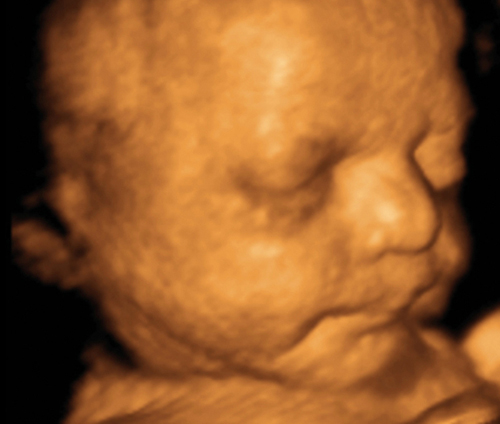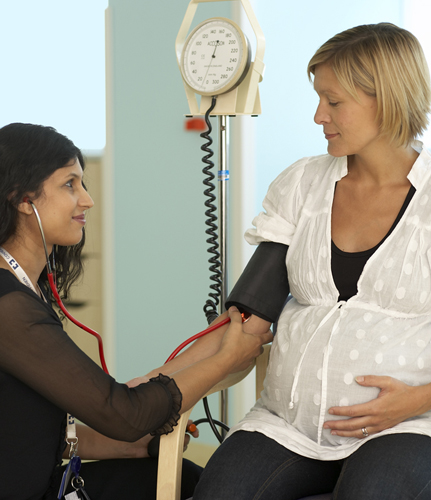You are 33 Weeks and 3 Days 46 days to go…
Most women want to wait as long as possible to start maternity leave, but you must make the decision that is right for you.
Your baby today
At this stage it is simply no longer possible to see the whole
baby on a scan. The ultrasound scan cannot not step far enough back to
include the whole baby in a single view. Instead it is necessary to move
the probe around, to examine one area at a time.

There is generally no risk in working up to the final month
of your pregnancy. You may decide to work right up until you deliver,
but by this week you are highly likely to find it increasingly tiring.
If you are feeling exhausted and you think you might want to start your
leave sooner, speak to your boss without delay. Hopefully, he or she
will be understanding, but realize that if you start your maternity
leave early, you may have to come back to work sooner (see Your Rights and Benefits).
But if you are struggling to cope with the discomforts of late
pregnancy, the decision to take sick leave during the last four weeks
may be the right move for you. Talk to your doctor and your employer as
soon as you make this decision.
Another desirable option is
to work flex-time, so that you can travel to work at a less busy time
and, if it’s possible with your type of employment, work from home
sometimes to cut out some of the commuting.
… Your health
Essential checks
Some of the regular tests you will have in the third trimester are designed to check for preeclampsia.
A combination of high (or rising) blood pressure and protein in your
urine can be an indication of preeclampsia; another sign of this
condition is extreme swelling, particularly of the face and/or ankles.
Your blood pressure will be monitored regularly at this stage because a high reading can be a sign of preeclampsia.

… Doctor
| Q: |
Will I have to give back my maternity pay if I decide not to return to work after the birth of my baby?
|
| A: |
This is a little bit complicated, and it’s a good idea to get some legal advice.
In a nutshell, if you do not want to return to work after your maternity leave, you must resign.
Bear in mind
that every situation is different, and every company has a different set
of rules and guidelines. You should let your company know of your
decision as soon as possible. Make an appointment with your human
resources representative to discuss your company’s policies with you so
you have plenty of time to think about your options. Also keep in mind
that if your company let you take vacation or sick days that you haven’t
yet accrued as part of your leave, they may ask you to reimburse them
for those days if you’re not returning to work.
This happens quite
often, and your boss may not be surprised to hear that you’re not
returning to work. And if you’re not 100 percent certain about not
returning to work, it may be a good idea to ask your employer about
coming back to work on part-time basis or working from home one or two
days a week, if that’s feasible.
|
You are 33 Weeks and 4 Days 45 days to go…
The size of your belly will increasingly be due to the baby alone as the amniotic fluid now reduces slightly each week.
Your baby today
A foot is shown here with the toes spread out. Not all of the
movements that you feel will be due to kicks, some movements will be
shrugs or punches and some from the bottom or head as it touches the
sides of the uterus.

The amount of amniotic fluid that surrounds and protects your baby is now at its maximum and the placenta has almost completed its growth.
Amniotic fluid is
essential for your baby’s lung development, gut maturation, protein
requirements, and temperature control. Adequate fluid also allows your
baby to move easily since she is in an almost weightless state. There is
about 800 ml of amniotic fluid around your baby. The range, however, is
quite wide and “normal” can be anywhere between 300 ml and 2 liters.
Sometimes there is too little, a condition known as oligohydramnios, or too much fluid, a condition known as polyhydramnios, surrounding the baby. In this situation you would be closely monitored and premature delivery may be necessary.
It’s not surprising that
the size of your uterus may not reflect the size of your baby since
there can be so much variation in the quantity of fluid.
As the amount of
amniotic fluid reduces in late pregnancy, your baby is not as well
cushioned and her movements may become more obvious, although you should
bear in mind that increasingly, as she grows, she has less space in
which to move around.
… Dads
What’s in your hospital bag?
Once your partner’s labor begins,
your attention will need to be focused on helping her both practically
and emotionally. So in addition to helping your partner prepare her
maternity bag in advance, it’s a good idea to prepare a bag of your own.
Understandably, dads
are not always well supported in delivery units, and certainly don’t
get fed. You’ll also find that you’re at the hospital for several hours.
Text messaging is an effective way to inform some family and friends about the birth. Make sure you’ve entered all the numbers into your phone before the big day.

Consider packing the following:
Snacks
Drinks
A pillow
Something to read or play
A reasonable amount of change to pay for parking and to buy snacks, juice, and soft drinks if they’re in vending machines
A list of phone numbers, or enter them into your cell phone now
A camera.
One of the most common concerns for women in late pregnancy is that their water will break in public.
The reality is that the
amniotic fluid is unlikely to gush out. It is much more likely to
trickle out because in a head-down position, the baby will press down on
the cervix and prevent the liquid from escaping. If it does happen in
public, don’t worry—you won’t be short of people offering help.